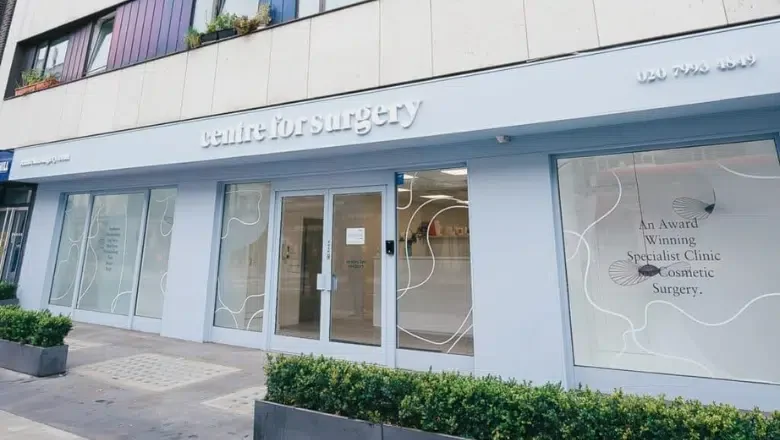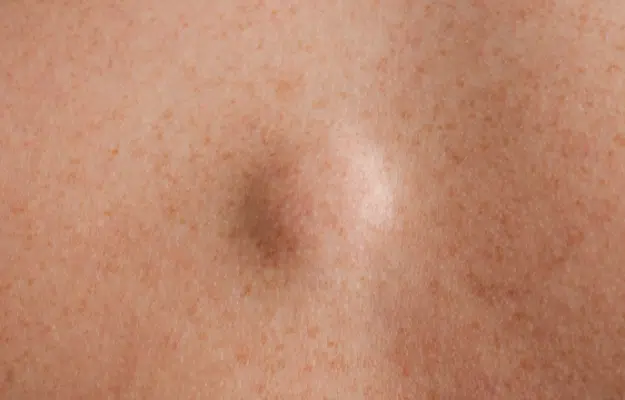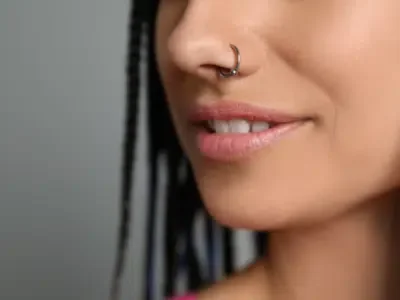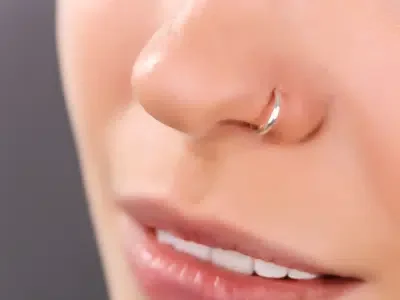What Should I Do About the Bump on My New Nose Piercing?
Experiencing a bump on your nose after a piercing is not uncommon and typically requires straightforward care at home, such as regularly cleaning the pierced area and potentially switching your jewellery. However, consulting a doctor becomes essential if you exhibit signs of an infection.
A fresh nose piercing can naturally show signs of swelling, redness, and some bleeding or bruising within the initial weeks. During the healing process, it is common for the area to itch and for a crust to form around the jewellery, indicating the body’s natural healing response.
The complete healing of a nose piercing can take several months. Throughout this period, it’s important to monitor any changes or escalations in symptoms. The appearance of a bump on your nose piercing can often suggest a complication.
Continue reading to discover more about the causes of nose piercing bumps and the effective management strategies regularly used at Centre for Surgery.
What are the different types of nose piercing bumps?
Pustules
Resembling common skin blemishes, pustules are red and pus-filled, often manifesting around the piercing site. These bumps may or may not be painful but commonly present with itching, pain, and a burning sensation, indicating irritation or infection. Pustules typically arise due to factors such as mechanical stress on the piercing from tugging or pulling, bacterial infections, or external trauma—such as an impact during contact sports or snagging the jewellery on clothing. When a pustule causes significant discomfort or pain, consult a doctor to explore effective treatment options, such as topical or oral antibiotics. Early intervention can help mitigate the risk of the bump worsening and leading to further complications. Regular cleaning and gentle handling of the piercing are essential preventive measures to avoid the development of pustules.
Granulomas
These bumps are identifiable by their delayed appearance, emerging weeks to months after the initial piercing. Granulomas form adjacent to or directly within the piercing hole as a natural inflammatory response to the physical trauma of piercing. The tissue in the area proliferates in an attempt to heal, filling in the newly created space. Although granulomas are not inherently indicative of an infection, they can serve as a precursor to one if proper hygiene and care measures are not followed. Managing granulomas involves diligent cleaning of the piercing with recommended solutions to prevent infection. Refraining from touching or picking at the bump is also crucial, as this can cause bleeding and lead to secondary infection. If a granuloma does not resolve with basic care, seeking medical advice for potential treatment options like steroid creams or other anti-inflammatory medications is advised.
RELATED: Pyogenic Granuloma Removal
Keloids
Keloids represent a more severe form of scar tissue that overgrows beyond the wound boundaries, forming thick, puckered, itchy, or sometimes painful bumps over the piercing site. Susceptibility to keloids can vary greatly among individuals, with some people predisposed to developing them as a genetic trait. If you have previously developed keloids from piercings or injuries, new piercings will likely also produce keloids. Preventive consideration is crucial for individuals prone to this condition. Consultation with a doctor at Centre for Surgery can help determine if a bump is indeed a keloid and discuss potential interventions. Treatment options at our practice may include procedures to remove the keloid tissue, thereby improving the appearance and comfort of the piercing area. Such treatments address aesthetic concerns and alleviate any discomfort associated with keloid formation, allowing individuals to continue enjoying their body art without significant complications.
RELATED: How Do I Get Rid of a Keloid on my Nose Piercing?
Surgical Treatments for Nose Piercing Bumps
Surgical options may be considered when conservative methods for managing nose piercing bumps are insufficient. These treatments are particularly relevant for persistent bumps such as keloids or severe granulomas, where non-surgical interventions have failed to produce satisfactory results. Here’s a detailed look at the surgical treatments available:
Cryotherapy
This treatment involves freezing the bump, typically a granuloma or keloid, with liquid nitrogen. Cryotherapy helps reduce the size of the bump by causing the abnormal tissue cells to die off. The procedure is relatively quick and is usually performed with local anaesthesia to minimise discomfort.
Steroid Injections
Injecting steroids directly into the bump can significantly reduce inflammation and size. This method is particularly effective for hypertrophic and keloid scars, as it helps to flatten and soften the scar tissue over time. Multiple sessions may be required to achieve optimal results.
RELATED: Do Hypertrophic Scars Go Away?
Surgical Removal
For large or particularly stubborn bumps, surgical excision might be necessary. This procedure involves cutting out the bump entirely and is typically used for keloids that do not respond to other treatments. Depending on the size of the excision, surgical removal requires local anaesthesia and may involve sutures. Surgical removal of keloids can have a risk of recurrence, and additional preventive treatments may be recommended after surgery.
Laser Therapy
Laser scar treatment can be an effective option for reducing the appearance of bumps, particularly keloids and hypertrophic scars. Lasers work by targeting the excess scar tissue with intense light beams, which help to break down the scar tissue over several sessions. This method is less invasive than surgical removal and is known for its precision and minimal recovery time.
Silicone Gel Sheets
While not a surgical treatment per se, using silicone gel sheets can be an adjunct therapy after surgery. These sheets are placed over the healed piercing site to help flatten and soften scar tissue. They work by hydrating the scar and regulating fibroblast production, which can significantly improve the appearance of scars over time.
How to Minimise the Risk of Developing Bumps after Nose Piercings
While it’s impossible to guarantee that a nose piercing bump won’t occur, there are effective steps you can take to significantly reduce the risk of complications, such as infections, which often lead to bump formation. Ensuring cleanliness throughout the healing process is paramount.
Choose a Professional Piercer
The first step in a successful piercing experience is to ensure a professional piercer does it. This individual should be well-trained, knowledgeable about sterile techniques, and equipped with the proper tools. A reputable piercer operates in a clean environment and adheres to all safety regulations, significantly reducing the risk of infection.
Maintain Initial Jewellery
After getting your piercing, leaving the original jewellery in place is crucial until the area has completely healed. Early removal or frequent changes of the jewellery can irritate the piercing site, disrupt the healing process, and increase the likelihood of bump formation.
Wash Your Hands Regularly
Always clean your hands thoroughly before touching your piercing. This simple but vital step prevents the transfer of bacteria from your hands to the piercing site.
Clean the Piercing Properly
It is recommended to clean the piercing twice daily using a saline solution. This helps to keep the area clean and free from infectious agents. Ensure you’re gentle during this process to avoid aggravating the piercing.
Care for Your Jewellery
In addition to cleaning the piercing itself, it’s also important to regularly clean your jewellery with soap and water. This removes any build-up of skin cells, dirt, and bacteria that could potentially cause irritation or infection.
Avoid Interference
Resist the urge to touch, pick, or scratch at the piercing, especially if you notice bumps or crusting. Disturbing these areas can lead to wounds and increase the risk of scarring or further infection.
Exercise Patience
Healing times can vary, but typically, a nose piercing may take between three to six months to fully heal. Patience is key during this period. Allowing the body to heal at its own pace without interference is essential for a healthy outcome.
Schedule a Consultation at Centre for Surgery: Your Path to Expert Care
At Centre for Surgery, we are committed to providing the highest standard of care in aesthetic and reconstructive procedures, including the management of complications such as nose piercing bumps. Our state-of-the-art clinic in London is equipped with advanced medical technology and staffed by experienced specialists who are dedicated to ensuring the best outcomes for our patients.
Why Choose Centre for Surgery?
- Expert Team: Our team comprises highly trained and skilled professionals who specialise in a variety of surgical and non-surgical treatments. We ensure that all procedures, from initial consultation through to post-operative care, are conducted with the utmost precision and care.
- Advanced Techniques: We utilise the latest techniques and technologies to provide treatments that are both effective and minimally invasive, ensuring quicker recovery times and optimal results.
- Patient-Centric Approach: At Centre for Surgery, every treatment plan is tailored to meet the individual needs and goals of our patients. We take the time to understand your concerns and provide clear, detailed explanations of all available options.
Consultation Process Scheduling a consultation is the first step towards addressing your concerns about nose piercing bumps. During your consultation, you will:
- Meet directly with one of our specialists who will assess your condition.
- Receive a detailed explanation of potential causes and the various treatment options available, including both surgical and non-surgical approaches.
- Have the opportunity to ask any questions you may have regarding your specific situation and the expected outcomes.
How to Schedule Your Consultation To arrange your consultation, you can contact us in several convenient ways:
- Phone: Call us at 0207 993 4849 to speak with our friendly staff who can schedule an appointment at a time that suits you.
- Email: Send an email to contact@centreforsurgery.com with your inquiries, and one of our team members will get back to you to arrange a consultation.
We understand the importance of addressing aesthetic concerns and are here to provide the support and expertise you need to achieve the best possible results. Whether you’re dealing with a new or longstanding issue related to a nose piercing, our team at Centre for Surgery is here to help you every step of the way.










